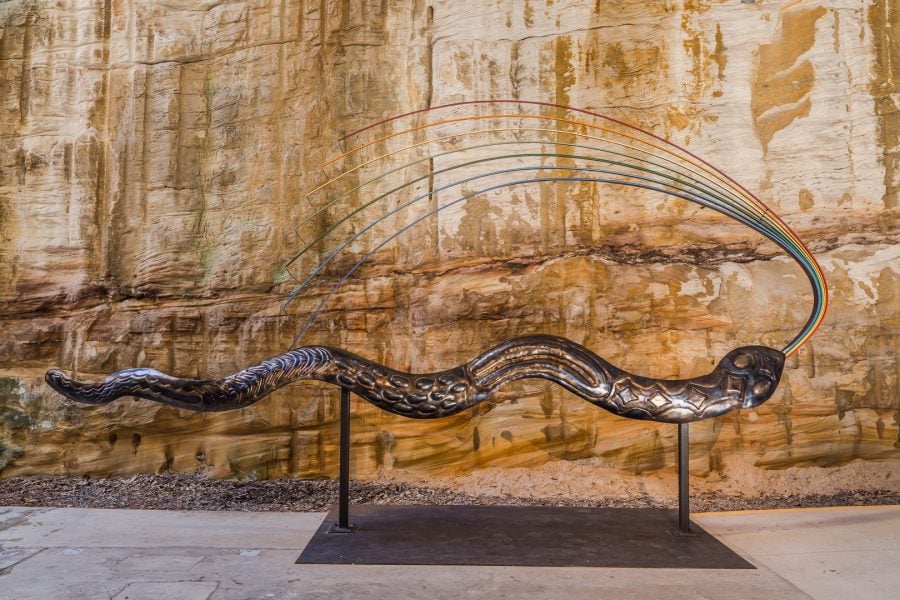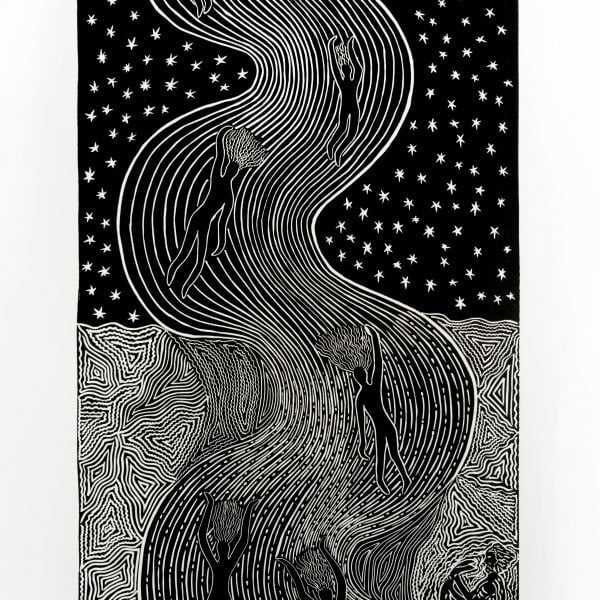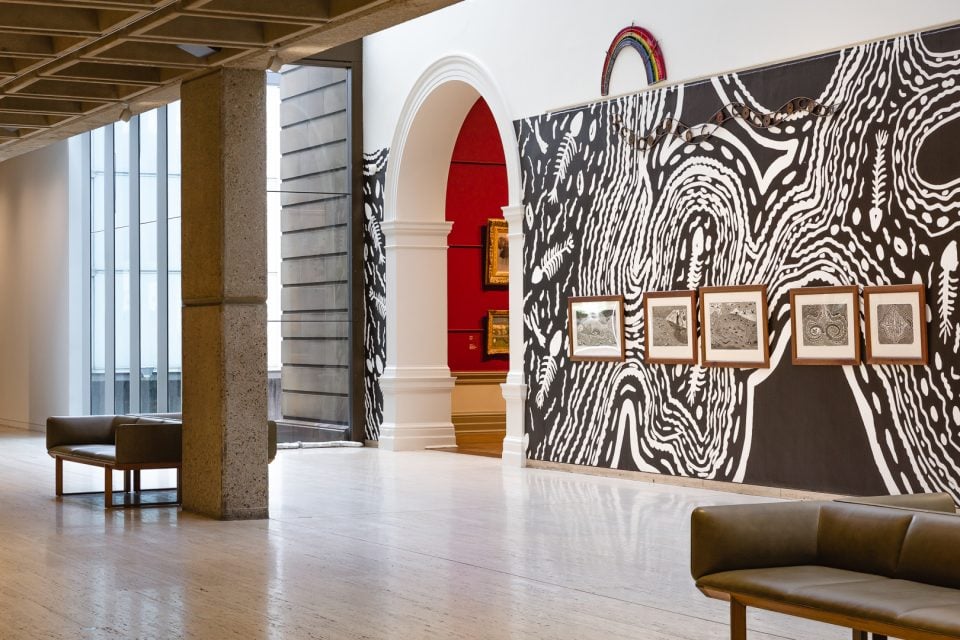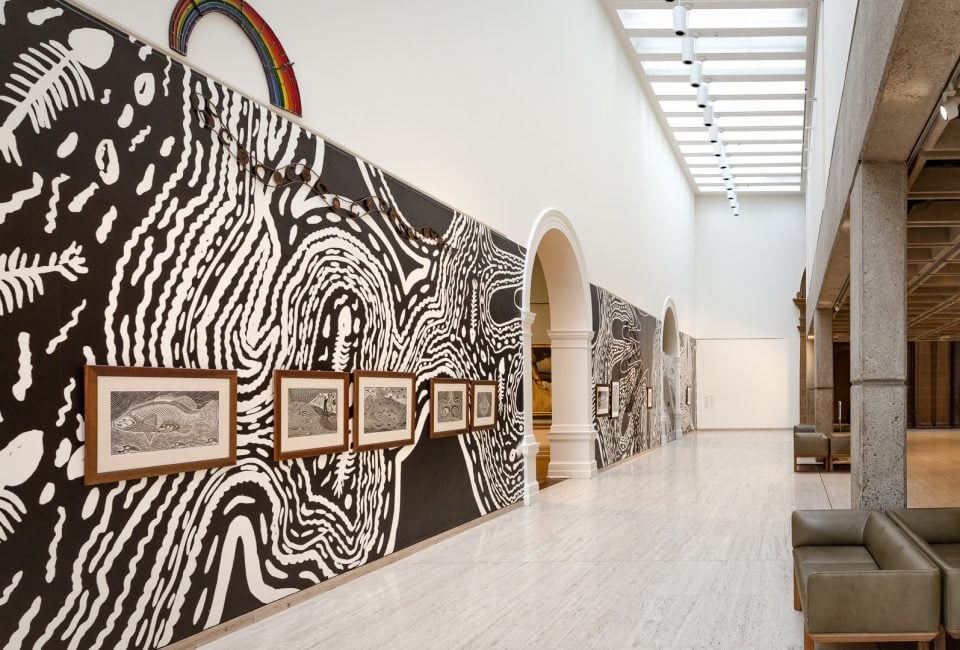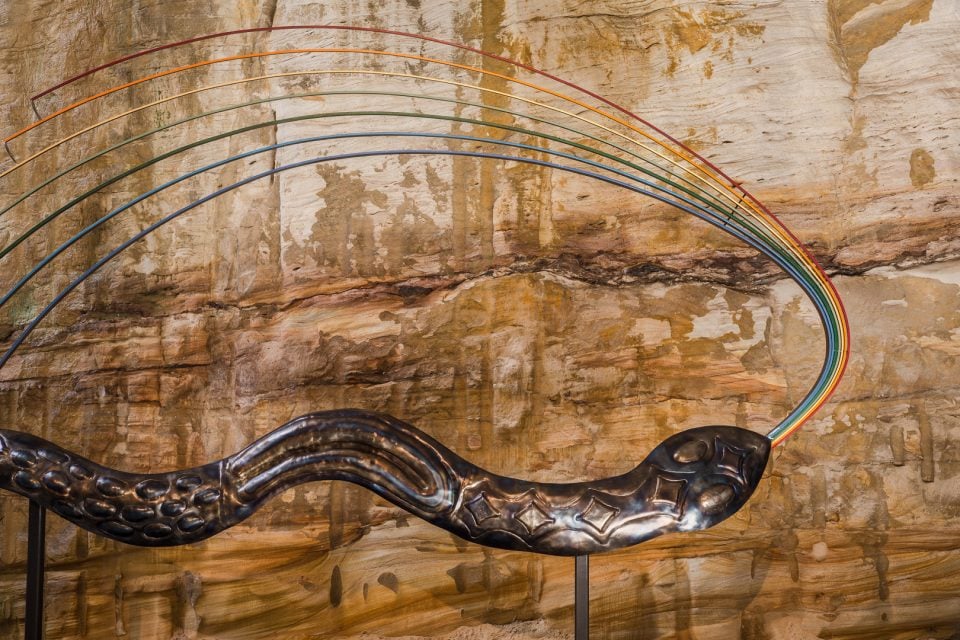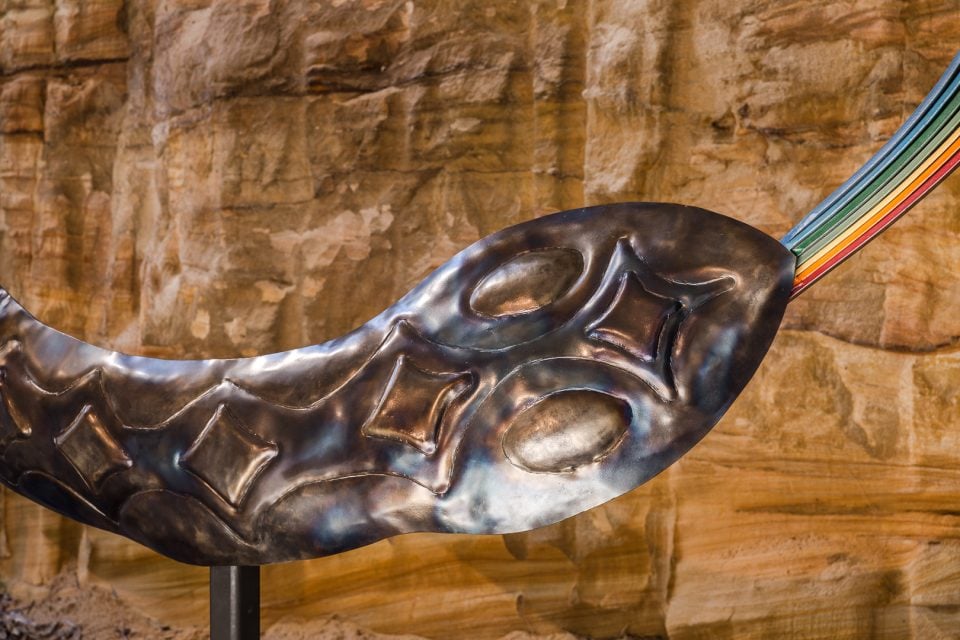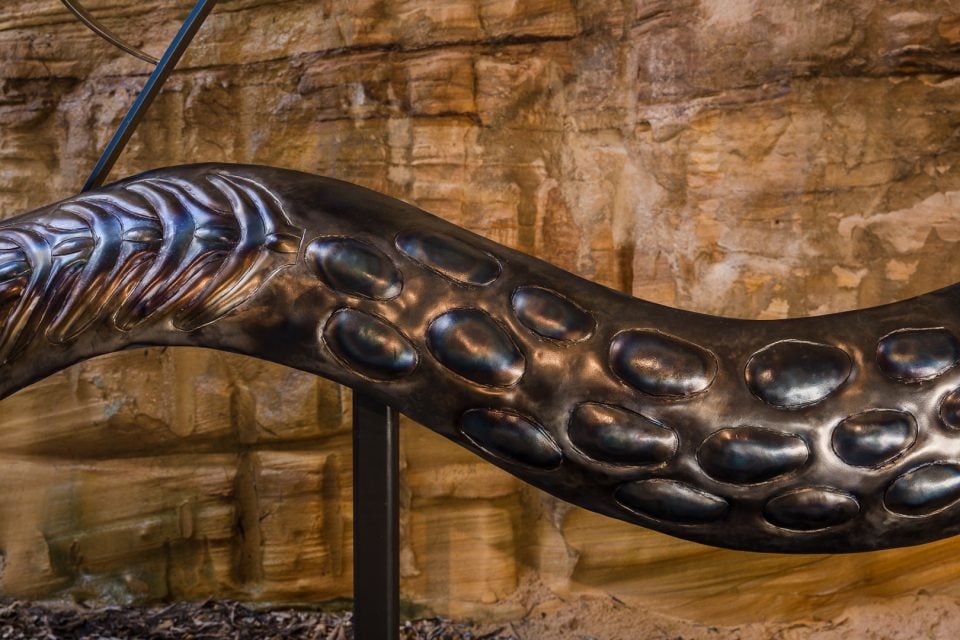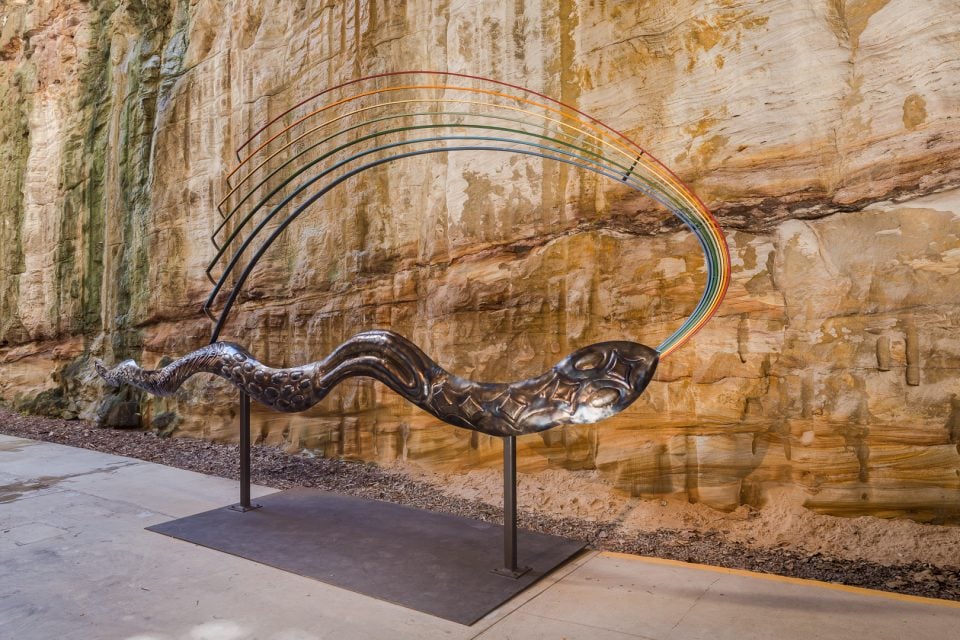The Cutaway
Save our Ngatji (Rainbow Serpents), creators of spiritual rivers connecting water, sky, and land, 2022
steel
Courtesy the artist. Made in collaboration with Matt Mewburn and the team at Eveleigh Works.
Commissioned by the Biennale of Sydney with generous support from the Australia Council for the Arts
Badger Bates was born on the Barka (Darling River). His identity is deeply entwined with the river, and his practice as an artist, cultural heritage consultant and environmental activist incorporates the landforms, animals, plants, songs and stories of Barkandji Country and the Barka. As such, his work cannot be thought of alone as art. It requires an understanding of the importance of the river and efforts to protect it to his culture and sense of self.
At the entrance to the Cutaway – a site where fresh and saltwater meet – Badger presents a sculptural Ngatji (rainbow serpent), produced in collaboration with blacksmith Matt Mewburn. The Ngatji is associated with the creation of the Barka and is a central motif in Bates’ world. Shimmering against the sandstone wall, it reminds people of the connection that Indigenous Australians have to this country, that non-Indigenous Australians belong to a landscape shaped by deep histories, and that any collective vision of the future must have Aboriginal people and the survival of their lands and culture at its centre.
It is our belief that the Ngatji is still with us and it will make rain. The thunder is the Ngatji rumbling and growling and they blow the rainbow after rain because they can go back on their journeys then…They created all the water and country when they travelled around.
– Badger Bates
Since 2017 the Art Gallery of New South Wales has worked each year with Wilcannia community, Broken Hill Regional Art Gallery and Wilcannia Central School to deliver the Djamu program for Indigenous art education. In 2020, as part of the Djamu Regional program, Barkandji Elder Uncle Badger Bates led a collaborative project to cut the first Barkandji canoe in more than 70 years.
Cut by hand from a river red gum in Wilcannia, the canoe made its maiden voyage on the Baaka (Darling River) in December 2020. Students and staff at Wilcannia Central School, the Wilcannia community and the Aboriginal and Torres Strait Islander art team from the Art Gallery all assisted in the making of the canoe.
Art Gallery of New South Wales
Barka the forgotten river and the desecration of the Menindee Lakes 2021–22
wallpaper
Courtesy the artist
Commissioned by the Biennale of Sydney with generous support from the Australia Council for the Arts
Barka (Darling River) 1992
linocut print
Courtesy the artist
Bush tucker on the Paroo 1996
linocut print
Courtesy the artist
Parntu thayilana wiithi (Cod eating yabbies) 2004
linocut print
Courtesy the artist
No more catfish 2004
linocut print
Courtesy the artist
Wiimpatja paakana nhaartalana (Me fishing in the Darling River) 2004
linocut print
Courtesy the artist
Ngatyi yarilana (Rainbow Serpents having young) 2007
linocut print
Courtesy the artist
Brolgas dancing at Peery Lake 2008
linocut print
Courtesy the artist
Warrego–Darling junction, Toorale 2012
linocut print
Courtesy the artist
Barka the forgotten river and the desecration of the Menindee Lakes 2018
linocut print
Courtesy the artist
Ngatyi blowing a rainbow 2018
glass leadlight, metal and found objects
Courtesy the artist
Drying lake 2018
steel and tin
Courtesy the artist
Presentation at the 23rd Biennale of Sydney (2022) was made possible with generous support from the Australia Council for the Arts
Badger Bates’ linocuts are ubiquitous and enduring representations of Barkandji Country. Primarily a carver, his works on paper, carved wood and stone and, more recently, sculpted metal breathe life to his knowledge of the Baaka (Darling River), its tributaries and lake systems, and of the teachings of his grandmother, Granny Moysey.
The black-and-white prints that depict the ecosystems and histories of far west NSW create counter-narratives to colonial tales of the pioneering spirit, and to romanticised stories of European explorers perishing in desolate and hostile environments. Bates presents landscapes teeming with life, sustained by the serpentine force of the Baaka (Darling River), yet he layers this with depictions of fish kills and nature in a state of flux – an urgent message of water systems being desecrated by extractive industries.
‘When they take the water from a Barkandji person, they take our blood. They’re killing us. It’s not just us Barkandji people who are feeling it. It’s the white people and other people too. How can I teach culture when they’re taking our beloved Baaka away? There’s nothing to teach if there’s no river. The river is everything. It’s my life, my culture. You take the water away from us, we’ve got nothing.’
Badger Bates, 2018
Badger Bates
Born 1947 in Wilcannia, NSW
Lives and works in Broken Hill, NSW
Barkandji
with Anthony Hayward
Born in Broken Hill, NSW
Lives and works in Broken Hill
Ngiyampaa
and David Doyle
Born 1979 in Menindee, NSW
Lives and works in Broken Hill, NSW
Barkandji
Barkandji canoe 2020
river red gum bark, resin
Courtesy Badger Bates, Anthony Hayward and David Doyle
Presentation at the 23rd Biennale of Sydney (2022) was made possible with generous support from the Australia Council for the Arts
Special thanks to the students and staff at Wilcannia Central School, the Wilcannia community and the Aboriginal and Torres Strait Islander art team from the Art Gallery of New South Wales who assisted in the making of the canoe as part of Djamu Regional
Mungabuttaka 2021
nelia
Courtesy the artist
Mungabuttaka 2021
nelia
Courtesy the artist
Karnka 2021
mulga
Courtesy the artist
Wanna 2019
river red gum
Courtesy the artist
Wanna 2019
black box
Courtesy the artist
Coolamon 2021
black box
Courtesy the artist
Nulla nulla 2019
mulga
Courtesy the artist
Presentation at the 23rd Biennale of Sydney (2022) was made possible with generous support from the Australia Council for the Arts
